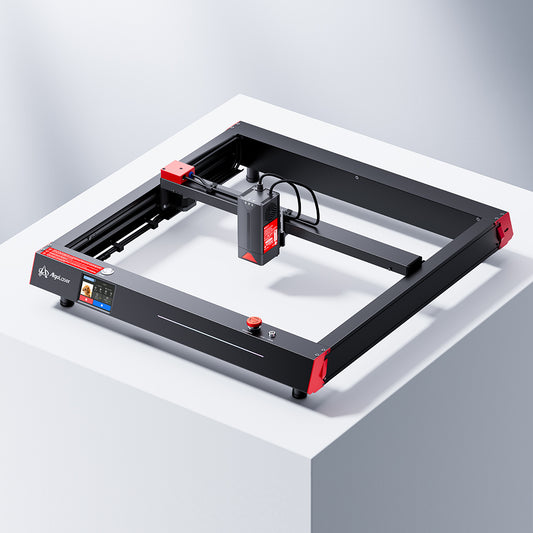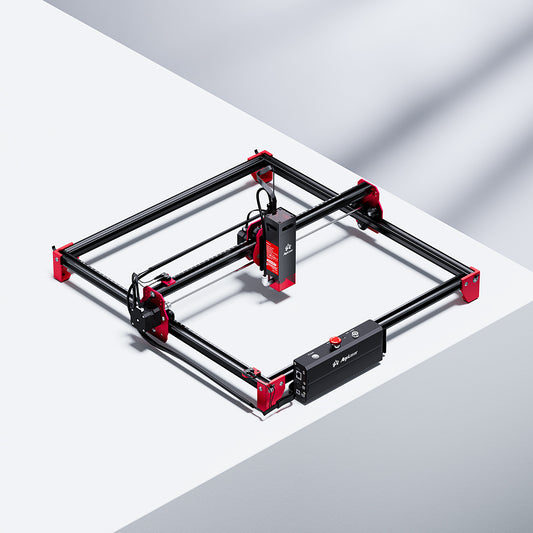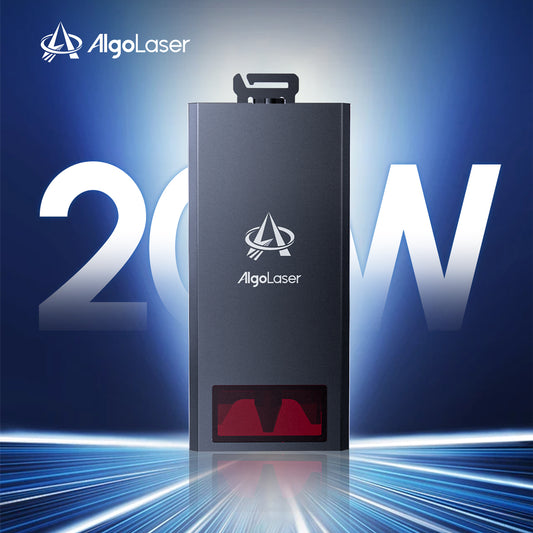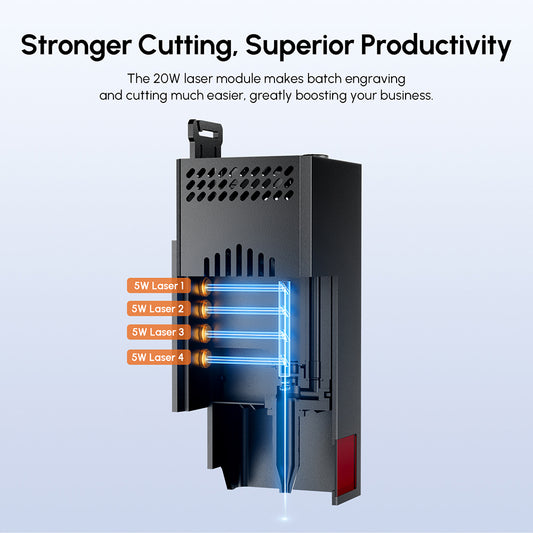The Creator's Journey: Turning Metal and Light into Art with a Laser Engraver
The creator's journey begins with a spark — that quiet voice saying, "What if I could make this myself?" My first experience with the AlgoLaser Alpha MK2 and the 1064 module wasn't flawless. The engraving was too deep, and the metal bent slightly from the heat. But that moment changed everything. I realized that creating with a laser engraver isn't about perfection; it's about discovery.
Working with metal — stainless steel, aluminum, brass — demands patience and precision. The 1064 module opened a new world for me, turning raw material into art. Every engraving feels personal, whether it's a logo on steel, a message on a tumbler, or a custom tag for a friend. Watching the laser trace each line feels like watching creativity made visible.
Over time, my workspace transformed into more than a studio — it became my sanctuary. The soft glow of the laser, the quiet hum, the scent of freshly engraved metal — it's a rhythm that keeps me grounded.
A laser engraver isn't just a tool; it's a storyteller. Each project carries emotion, memory, and meaning. That's the real beauty of this craft — every mark you make leaves a trace of who you are.

1. Latest Types of Metal Laser Engraving Machines
When it comes to choosing a laser engraving machine for metal, it helps to know the main types available today, how they differ, and where each one shines.
Fiber Lasers
These are widely recognised as the best type for metal engraving and marking. Because they use an ytterbium-doped fibre and produce ~1064 nm wavelength (in the infrared) — this wavelength is well absorbed by most metals. According to an industry guide:
"Fiber lasers are the best laser engravers for metal because of their speed, precision, and efficiency."
Laserax
They can achieve deep engraving, high contrast etching, and are often used in industrial applications. They also tend to be more expensive.
If you're serious about industrial laser engraver for metal, acquiring a fibre laser machine is often the gold standard.
Diode Lasers & 1064 nm IR Modules
In more budget or workshop environments, diode lasers are often used — especially when paired with an IR module (1064nm) which improves metal marking compared to visible-wavelength diodes.
As the guide says:
"Diode lasers can be used to engrave metals if the engraving needs are relatively simple and low power."
If you're using your Alpha MK2 with a 1064 nm module (which you are), you're playing in this space: a high‐quality workshop machine that punches above its weight for metal marking/engraving without going full industrial fibre laser scale.
CO₂ Lasers
These are more suited for organic materials (wood, acrylic, leather) because their ~10.6 µm wavelength is not well absorbed by bare metal surfaces.
That said, they can mark metals IF the metal is coated (anodised aluminium, powder-coated steel) and you use the laser to remove the coating, or you apply a marking spray.
In other words: A laser engraver for metal based on CO₂ will have to rely on coating removal or auxiliary methods — not the ideal path if you want deep, direct metal engraving.
Hybrid & Advanced Marking Machines
Some newer machines combine fibre/diode or offer hybrid tech (MOPA fibre lasers, pulsed vs CW, with galvanometer scan heads) for high speed, high precision.
For example, machines that offer "3-Axis Hybrid Laser Marker" or "3-Axis Fiber Laser Marker" from companies like KEYENCE are examples of this.
What to Choose — A Quick Checklist
Since you already understand the value of your Alpha MK2 and its 1064 nm module, here's what to think about when choosing or upgrading your machine:
· Wavelength: 1064 nm is ideal for most metals; if you're engraving coated metal, you might get away with other wavelengths, but absorption is key.
· Power / Pulse vs Continuous: Higher power (and the right pulse width) allows deeper engraving, faster marks.
· Beam quality / spot size: Finer spot = higher detail.
· Work area & motion system: How big are your parts? Do you need rotary attachments?
· Cooling / maintenance / longevity: Fiber lasers tend to be more efficient and low-maintenance. Diodes are cheaper but may require more trade-offs.
· Material compatibility: Are you engraving bare metal? Coated metal? Mixed materials (metal + wood)?
· Budget & space: Industrial fibre systems are high cost; workshop machines (like yours) are more affordable.
· Software & workflow: Ease of use, integration with your workflow (e.g., your blog writing, your brand's production) matters.
· Safety & ventilation: Metal engraving can produce fumes, smoke, reflections — plan for air-assist and extraction.
Given your focus (metal engraving, using the Alpha MK2 in a workshop context with the 1064 module) you're in a strong position to get excellent results without paying full industrial fibre-laser pricing.

2. Metal Laser Engraving Materials & Methods
Now let's dive into the materials you'll work with, and the methods that bring those materials to life under the beam of a true laser engraver for metal.
Materials
Here are some common metal substrates encountered when using the laser engraving machine for metal:
· Bare aluminium / anodised aluminium: Anodised aluminium is popular because it offers a coloured coating that the laser can remove or alter, producing high-contrast results.
· Stainless steel: Strong, durable, and popular for industrial parts, nameplates, jewellery etc.
· Steel (mild, alloy): Heavier duty, cost-effective, good for industrial parts.
· Copper, brass: More challenging due to reflectivity and thermal properties, but achievable with the right setup.
· Coated/Powder-coated metals: The coating provides contrast when removed, and the bare metal underneath shows the mark.
· Metal blanks for laser engraving: Pre-prepared plates, tags, tumblers, business cards etc. These are ready sub-substrates designed for engraving.
· Metal & wood combinations (for example metal inlays, or metal tags mounted on wood) if you’re doing mixed-material work.
Methods & Techniques
Here are core methods used with a laser engraving machine for metal:
Direct Engraving
This is where the laser beam physically removes material from the metal surface (vaporises or melts tiny amounts) leaving a cavity or permanently altered surface. For example, a fibre laser might create deep, durable marks.
This is ideal when you want durable, wear-resistant marks (industrial parts, tools, metal nameplates).
Surface Marking / Etching
Sometimes you don't need deep engraving — you might need high-contrast shallow marks (logos, serial numbers). This could be done by changing the surface microstructure (for example on stainless steel).
Laser annealing is another form: heating the metal surface so that a black mark forms beneath the surface, preserving original corrosion resistance.
Coating Removal
If the metal is coated (anodised, powder-coated, painted), a laser (even less ideal ones like CO₂) can remove the coating leaving the bare metal underneath, providing a contrast marking.
This is commonly used for metal blanks with pre-coated surfaces designed for laser marking.
Pre-Treatment & Post-Treatment
· Pre-treatment: Cleaning the metal surface (removing oil, dust), possibly applying marking sprays or contrast-enhancing coatings if needed.
· Focusing: Ensuring your laser module (like your 1064 module in the Alpha MK2) is correctly focused on the metal surface for optimum engraving.
· Parameter setting: Adjusting power, speed, pulse width, frequency, number of passes.
· Post-treatment: Cleaning the workpiece (removing debris, blackening if needed), maybe finishing with a protective coating if the part will be exposed to harsh environments.
Tips for Success
· Use appropriate power & speed: Too slow/powerful = overburn, too fast/light = faint mark.
· Focus and spot size matter especially on metal (reflective surfaces).
· Air assist and ventilation: metal engraving produces micro-debris, fumes, and reflections; safety is key.
· Test on sample blanks: different metals and coatings will respond differently.
· Understand "absorption" of the laser wavelength: metals reflect a lot of light; the 1064nm fibre/IR wavelength is much better than long-wavelength CO₂ for bare metals.
· Keep the work-area clean and stable; vibrations, thermal changes will affect engraved depth and clarity.
As the creator "Alex" learned: the machine is only part of the equation — the metal substrate + surface prep + correct method make all the difference.

3. Comparison chart
| Feature / Metric | Mini / Desktop Laser Engraver (metal-capable) | Industrial Fibre Laser Engraver / Marker |
|---|---|---|
| Representative models (examples) | AlgoLaser Alpha MK2 . (AlgoLaser) | Epilog Fusion (fiber marking options), Trotec SpeedMarker, industrial cabinets using Raycus / JPT sources. |
| Typical power / tech | Diode lasers (10–40W nominal diode modules) or small 1064nm IR modules added to diode platforms; sometimes galvo/diode combos. Good for coating removal, anodized aluminium, shallow marking. | Fiber lasers (20W–200W+ available). MOPA/fiber sources produce high peak power, very fast marking, deep engraving; galvo or XY stages for production. |
| Typical price (street / current market) | $300–$6,000+ depending on brand and options. Example: AlgoLaser 1064 module accessory ≈ $429 (module price). | Bench/production fibre markers: $5k–$50k for bench/top fiber systems (some compact fibre markers start in the mid-$4k–$10k). Full industrial fibre engraving/marking machines and cutters commonly start around $17k and rise to $40k–$150k+ depending on power, galvo, area and automation. (Epilog Fusion pricing starts ~$16,995). Used/installed industrial units (e.g., Trotec SpeedMarker) can be tens of thousands. |
| Best at | Hobbyists, artists, small businesses doing tumblers, tags, anodized aluminium, coated metals, mixed material projects (metal + wood). Good for prototyping. | High-volume marking, deep engraving in stainless steel, hard metals, industrial traceability marks, long duty cycles, automotive/aerospace parts, parts that need IEC certification and tight process control. |
| Marking depth & speed | Shallow marks to modest engraving depth; slower for deep engraving (may require multiple passes). Fast enough for one-off or small batch work. | Much faster for high-contrast marks and much deeper engraving per pass (higher peak power + shorter pulses). Built for continuous production. |
| Footprint & installation | Desktop/compact; minimal facilities (bench, basic ventilation recommended). Easy to integrate in small studios. | Larger footprint; may require industrial power, chiller/cooling, fume extraction, and safety interlocks. Often needs floor space and trained operators. |
| Maintenance & lifetime | Lower upfront cost, potentially higher per-hour cost (diode life shorter than sealed fiber modules); easier for one-person shops to maintain. | Designed for heavy duty; fiber sources (IPG, JPT, Raycus) are long-lived (10k–100k hours depending on model) and have professional service networks. |
| Software / workflow | Often consumer-friendly GUI, LightBurn compatibility, plug-and-play workflows. Good for designers and makers. | Industrial control software, automation APIs, PLC integration, higher levels of process control and traceability. |
| Typical buyers | Makers, jewelry designers, small shops, e-commerce sellers, prototypers. | Manufacturing shops, OEMs, medical, aerospace, automotive, high-volume suppliers, contract manufacturers. |
4. 10 Latest Laser-Engraved Metal Works
Here are ten inspiring examples (realistic but stylised) of what's possible when you combine the right machine + material + method. These works show the range of what a laser engraver for metal and wood, but here focused on metal, can achieve.
1. Deep-etched stainless steel industrial serial plate – A plate attached to heavy machinery, engraved with model number, manufacturer logo, QR code. Durable and legible after years of wear.
2. Anodised aluminium nameplate with white mark – Using the 1064 nm module to remove the anodised coat and reveal bright aluminium beneath, creating high contrast.
3. Custom metal tumbler engraving – A powder-coated steel tumbler engraved with a full-wrap design (logo + name + artwork) using laser marking on coating then finish.
4. Copper business card, laser engraved – Copper blank laser-marked with intricate pattern and text; after engraving, cleaned and sealed for a premium feel.
5. Brass jewellery piece – A brass pendant laser-engraved with fine detail; post-polished to reveal the mark in white/chrome finish.
6. Steel award plaque with relief engraving – Using a fibre-style process to create a shallow relief image etched into stainless steel, then fill-inked for contrast.
7. Aluminium art relief panel – Laser engraving machine for metal used to carve a stylised landscape into an aluminium panel, finishing with bead-blast and black fill.
8. Weapon-grade aluminium or steel component – For custom firearms accessory engraving (tags, slides, frames) using a 1064 nm laser engraver machine for metal, producing crisp logos.
9. Metal tags for industrial identification – Stainless or aluminium tags marked with laser for traceability; batch production using your workshop machine.
10. Wedding ring/bracelet metal engraving – Using small laser engraver for metal jewellery; engraving inside and outside of rings with text and micro-graphics.
These examples demonstrate the versatility: from industrial parts to art to gifts. They also suggest workflow ideas you can blog about: "how I set up the tumbler engraving job", "how I cleaned the brass jewellery after laser marking", etc.

5. Buyer's Guide: How to Choose the Best Laser Engraving Machine for Metal
Now, as a laser-engraving geek, you know you want a laser engraver machine for metal. Here's how to evaluate your options, especially if you're considering upgrading beyond your current setup with the Alpha MK2.
Key Criteria
1. Laser type & wavelength
· 1064 nm (fibre or IR diode) is ideal for most metals.
· If you're doing coated metals, other wavelengths may suffice (but with more limitation).
2. Power / spot size / quality
· Higher power and better beam quality = deeper, cleaner marks.
· For fine detail (jewellery, small tags) you want a small spot size and fine beam.
3. Work area / machine footprint
· How big are your parts? A tumbler requires a rotating fixture; a large plate might need a bigger bed.
· Portable vs bench vs industrial floor.
4. Material flexibility
· Do you only do metal? Or do you also want to engrave wood, plastic, glass? If mixed, you might need dual-mode.
· Example: "laser engraver for metal and wood".
5. Software and workflow
· User-friendly interface, compatibility with your design tools, DXF, AI, RELIEF etc.
· Good focus tools, camera alignment, automation.
6. Speed & throughput
· For hobby, speed matters less. For business production, faster speeds matter. Fiber lasers often excel here.
7. Maintenance & running costs
· Fibre lasers may cost more upfront but lower maintenance. Diodes are cheaper but may trade off quality.
8. Safety, ventilation & accessories
· Engraving metal needs proper extraction, fire safety, eye protection, and machine enclosure especially for reflective beams.
9. Budget
· Entry-level machines are possible (mini laser engraver for metal) but expect compromises. If you aim for "best laser engraver for metal" expect higher cost.
· Guides note industrial machines start at high cost.
10. Support, brand reliability, upgradeability
· Brands that support you, provide parts, spool upgrades are worth more.
· Since you're using AlgoLaser, you're already in a strong brand ecosystem; use that to evaluate.
Fit with Your Workshop & Goals
· You already have the Alpha MK2 with 1064 module: great. This gives you a strong foundation.
· If you're engraving mostly metal blanks, metal tags, tumblers, small plates, your setup is spot on.
· If you plan to scale to heavier industrial parts (thicker steel, high volume, deep engraving) you might consider a fibre-laser upgrade.
· If you also want to integrate wood/metal combos (metal inlays, wood and metal engraving) you might want a dual-mode or ensure your machine supports both materials well.
· Blog angle: Describe your decision-making process — why you chose this machine, what trade-offs you considered, and how it fits your brand (AlgoLaser) and workshop.
Common Mistakes to Avoid
· Buying a cheap diode laser engraver for metal without considering the reflectivity or absorption issues.
· Ignoring ventilation and safety when engraving metal — fumes and reflections matter.
· Neglecting surface preparation (metal cleaning, coating condition) — the best machine can't fix poor prep.
· Overlooking software and fixture setup for metal (rotary attachments, jigs, precision).
· Underestimating running costs or downtime.

6. Final Words
If I were Alex (our creator), I'd say:
"Buy the best machine you can afford that meets your core metal-engraving needs today — then photograph every job, document every test, blog your process. Because in the end, it's not just the machine, it's how you use it."
Remember, your readers (and your brand's followers) will value not just the specs of your laser engraving machine for metal, but your wisdom: how you set parameters, how you held tolerances, how you cleaned up post-process, how you solved problems. That's the real value you bring.





